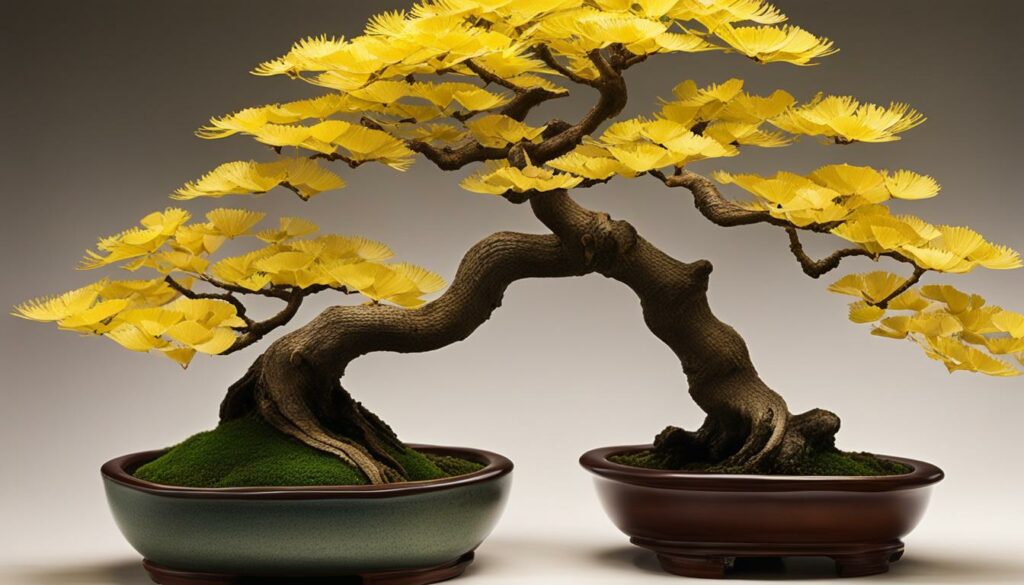If you’re seeking an extraordinary bonsai tree species that embodies both ancient wisdom and natural beauty, the Ginkgo bonsai is an excellent choice. Ginkgo biloba, also known as the maidenhair tree, has a rich history and has survived millions of years.
The Ginkgo bonsai is a deciduous tree, best known for its fan-shaped leaves that turn brilliant yellow in autumn. While it requires careful attention to its specific needs, once established, the Ginkgo bonsai is an incredibly resilient and adaptable tree that can live for hundreds of years.
In this comprehensive guide, you will learn everything you need to know about cultivating and caring for your very own Ginkgo bonsai, including unique insights into its cultural significance and historical associations.
Key Takeaways:
- The Ginkgo bonsai is an ancient and resilient species with fan-shaped leaves and a brilliant yellow autumn coloration.
- Cultivating Ginkgo bonsai requires careful attention to its specific needs, including ideal growing conditions, soil composition, and watering techniques.
- Caring for Ginkgo bonsai involves proper pruning, wiring, and positioning to optimize sunlight exposure and temperature regulation.
- Seasonal considerations are crucial for the successful growth of Ginkgo bonsai, including winter dormancy, spring rejuvenation, summer maintenance, and autumn coloration.
- Ginkgo bonsai offers endless possibilities for creative styling and design, including traditional and contemporary approaches to shaping and container selection.
The Ancient Ginkgo: A Living Fossil
The Ginkgo tree, scientifically known as Ginkgo biloba, is a remarkable species that dates back millions of years. This deciduous tree is often referred to as a “living fossil” due to its longevity and unchanged appearance over time.
The distinctive fan-shaped leaves of the Ginkgo tree make it a popular choice among bonsai enthusiasts. When cultivated as a bonsai, the Ginkgo creates a delicate yet striking representation of this ancient species.
Symbolism of the Ginkgo Tree
“The Ginkgo tree stands as a symbol of hope and peace, rooted in the past and persevering through the present to endure into the future.” -Japanese Proverb
The Ginkgo tree is associated with a range of symbolic meanings across different cultures. In China, it is considered a symbol of longevity and resilience. In Japan, it is often featured in religious and spiritual contexts, representing hope, peace, and endurance. In Korea, the Ginkgo is a national symbol, symbolizing strength and unity.
As a bonsai, the Ginkgo tree represents patience, harmony, and serenity, allowing us to connect with the ancient wisdom of this remarkable species.
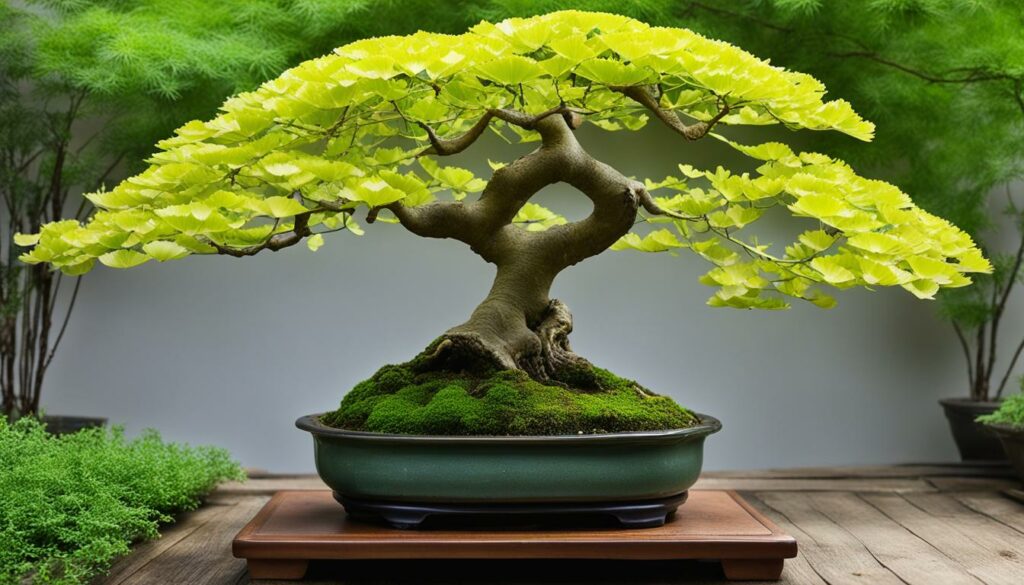
Creating a Ginkgo bonsai offers an opportunity to showcase the beauty and symbolism of this ancient species in a living form. In the next section, we will explore how to cultivate and care for your Ginkgo bonsai to ensure its health and vitality.
Cultivating Ginkgo Bonsai
Cultivating your own Ginkgo bonsai is a rewarding process that requires careful attention to its specific needs. By understanding the ideal growing conditions, soil composition, and watering techniques, you can ensure the health and vitality of your Ginkgo bonsai.
The optimal growing environment for Ginkgo bonsai is a sunny location with well-draining soil. These trees can tolerate a wide range of soil types, from neutral to slightly acidic, but prefer a loamy, nutrient-rich soil. Regular, deep watering is essential for healthy root development and foliage growth, but be careful not to overwater, as Ginkgo roots are sensitive to standing water.
Ginkgo bonsai thrives in full sunlight, which promotes healthy development and lush foliage. However, in hot or dry climates, it is important to provide some shade during the hottest part of the day to prevent leaf scorching.
Propagating Ginkgo bonsai can be done by seed or cuttings, but may take several years to reach maturity. Training techniques, such as wiring or pruning, can help shape your tree into a desired aesthetic, such as a formal upright or semi-cascade style. Remember to prune regularly to maintain shape and prevent overcrowding.
Ginkgo Bonsai Cultivation Guide:
| Needs | Details |
|---|---|
| Light | Ginkgo bonsai prefers full sunlight, but some shading is useful in hot or dry conditions. |
| Soil | The species can survive in various types of soil, as long as it is well-draining and nutrient-rich. The soil should be slightly acidic to neutral pH. |
| Watering | Ginkgo bonsai requires regular, deep watering to promote healthy root development. Avoid overwatering or standing water, which can damage the roots. |
| Propagation | Ginkgo bonsai can be propagated by seed or cuttings. However, it may take several years to reach maturity. Training techniques, such as wiring and pruning, can help shape the tree into a desired aesthetic. |
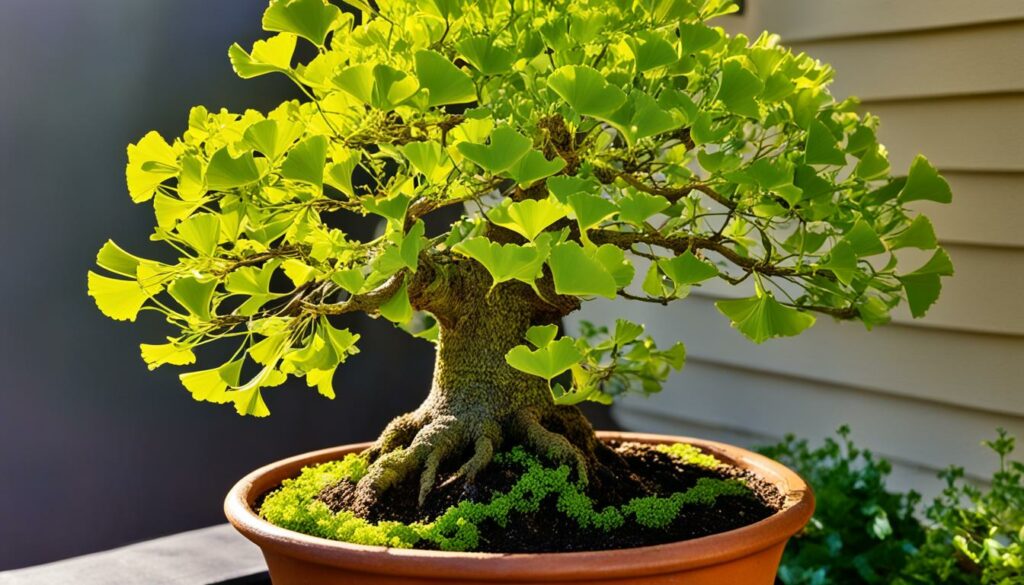
Remember, Ginkgo bonsai is a deciduous species, which means that it requires dormancy during the winter months. During this time, limit watering and exposure to extreme temperatures. Come spring, your Ginkgo bonsai will begin to flush new growth and rejuvenate for the upcoming growing season.
In the next section, we will cover how to properly care for your Ginkgo bonsai to ensure its long-term health and survival.
Caring for Ginkgo Bonsai
Proper care is essential for the long-term survival and overall health of your Ginkgo bonsai. In this section, you will explore the fundamental aspects of caring for your Ginkgo bonsai, from pruning to pest control.
Pruning
Pruning is an essential part of maintaining the shape and overall health of your Ginkgo bonsai. Regular pruning can also help improve the tree’s foliage density and prevent pests and diseases.
Use specialized bonsai trimming shears to remove new shoots and branches that are not in line with the overall design of your bonsai. Aim to remove no more than 30% of foliage and branches during any single pruning session.
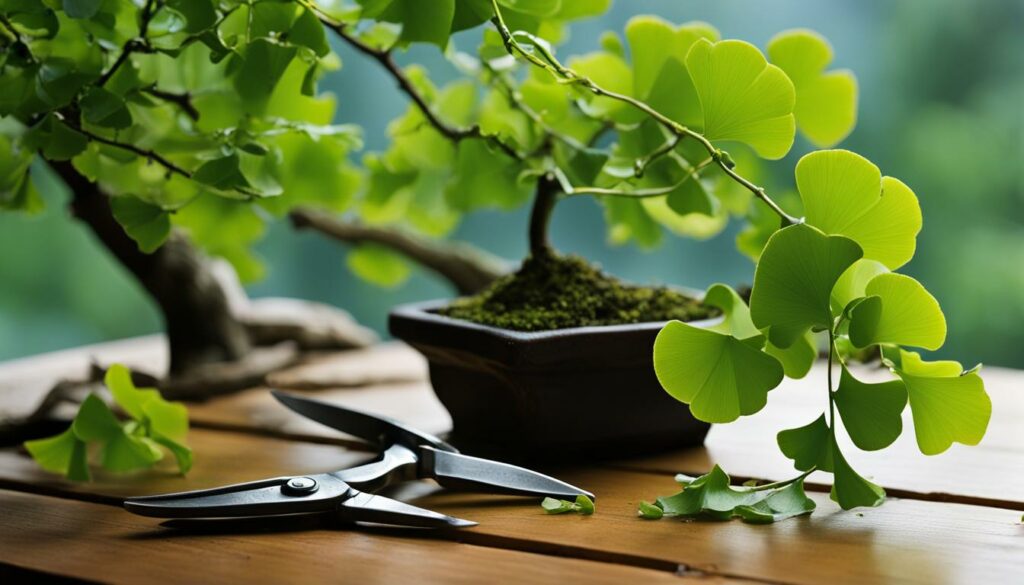
Wiring
Wiring is a valuable technique used in bonsai cultivation to shape and train your Ginkgo bonsai. Use specialized bonsai wire to wrap around branches and gently bend them into the desired shape. Be careful not to apply too much pressure, which can lead to damage.
Remove the wires after a few months to prevent them from cutting into the bark and causing damage.
Pest Control
Regularly inspect your Ginkgo bonsai for pests and diseases to prevent any severe damage. Some common pests that may afflict Ginkgo bonsai include spider mites, scale insects, and aphids.
Use specialized bonsai insecticides and fungicides to control and eliminate pests and diseases. Be careful not to apply too much, which can damage the tree further.
Positioning
Proper positioning of your Ginkgo bonsai is crucial for its overall health and well-being. Place your bonsai in a location that provides ample sunlight and proper ventilation while avoiding extreme temperatures.
During the winter, keep your Ginkgo bonsai in a temperature-controlled environment to prevent frost damage. Regularly monitor the soil moisture level and adjust watering accordingly.
Seasonal Considerations for Ginkgo Bonsai
Proper care for Ginkgo bonsai varies depending on the season. Take into account the following seasonal considerations to help ensure optimal growth:
Winter Dormancy
During the winter, Ginkgo bonsai requires reduced watering. Water only when the soil has completely dried out. Keep your Ginkgo bonsai in a cool, well-lit environment.
Spring Rejuvenation
As the weather warms up, increase watering frequency and begin to fertilize your Ginkgo bonsai. You may start to see new growth, which requires careful pruning. Ensure that your plant is getting enough light and avoid exposing it to strong winds.
Summer Maintenance
Summer is the time to maintain your Ginkgo bonsai by removing dead leaves, pruning excessive growth, and wiring branches into the desired shape. Ensure that your plant is not receiving excessive sunlight and water regularly during periods of drought.
Autumn Coloration
During the fall, your Ginkgo bonsai will exhibit beautiful yellow foliage. As the leaves begin to fall, reduce watering and move your plant to a cooler area. Be careful not to expose your Ginkgo bonsai to harsh winds or frost.
| Season | Watering | Fertilization | Pruning | Light Exposure |
|---|---|---|---|---|
| Winter | Water only when soil is dry | Avoid fertilization | Avoid pruning | Cool and well-lit environment |
| Spring | Water more frequently | Begin fertilization | Carefully prune new growth | Avoid strong winds |
| Summer | Water regularly during drought periods | Ongoing fertilization | Remove dead leaves and excessive growth | Avoid excessive sunlight |
| Autumn | Reduce watering as leaves begin to fall | Avoid fertilization | Prepare for winter dormancy | Cool and protected environment |
Note: Be sure to adjust your care routine according to your Ginkgo bonsai’s individual needs and the specific climate of your region.
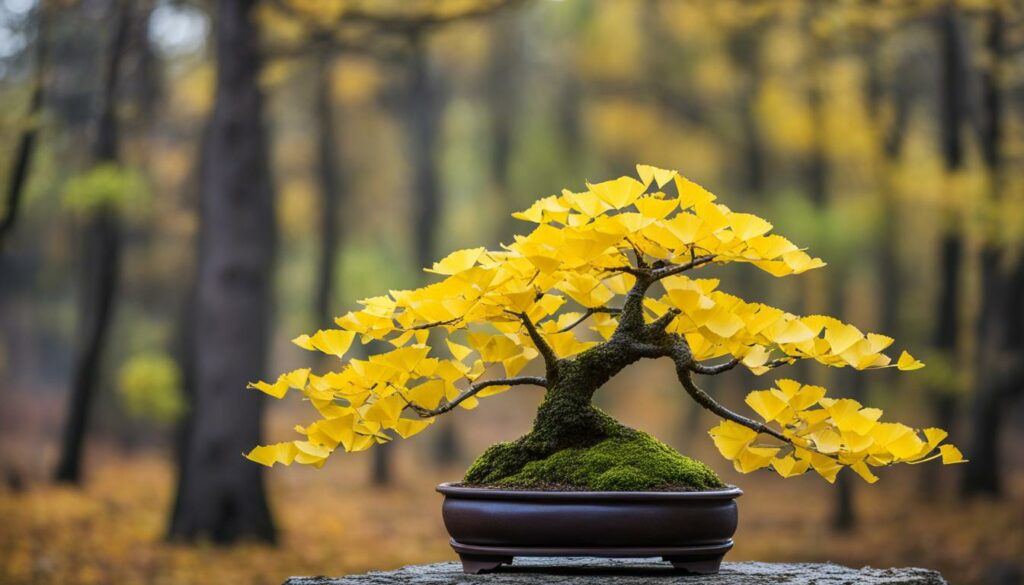
Ginkgo Bonsai Styling and Design
Styling and designing your Ginkgo bonsai is a creative and rewarding process. From traditional to contemporary, you have endless options for shaping and training your tree. One popular style is the formal upright, where the trunk grows upward in a straight line with defined branches. Another common style is the cascade, where the branches flow downward, resembling a waterfall. The windswept style mimics the look of a tree that has been shaped by natural forces, with branches leaning in one direction due to prevailing winds.
Selecting an appropriate container is also critical to the overall aesthetic appeal of your Ginkgo bonsai. Consider the size and shape of your tree and choose a container that complements its style. A rectangular container can accentuate a formal upright style, while a round or oval container can enhance a more organic shape.
Experiment with different styles and containers to find the perfect combination for your Ginkgo bonsai. Remember to balance artistic expression with the natural form of the tree to achieve a harmonious and visually pleasing final result.
Appreciating the Timeless Beauty of Ginkgo Bonsai
The majestic Ginkgo bonsai is a symbol of longevity, endurance, and resilience. This remarkable tree has deep cultural significance and historical associations, particularly in China and Japan, where it is revered as a sacred plant. The Ginkgo tree is believed to have spiritual and medicinal properties, and its leaves and seeds are used for various natural remedies and supplements.
The Ginkgo’s unique fan-shaped leaves turn a brilliant golden hue in the fall, making it a popular choice among bonsai enthusiasts, who appreciate its timeless beauty. As your Ginkgo bonsai matures, it will develop a rugged, weathered appearance, reminiscent of the tree’s ancient roots.
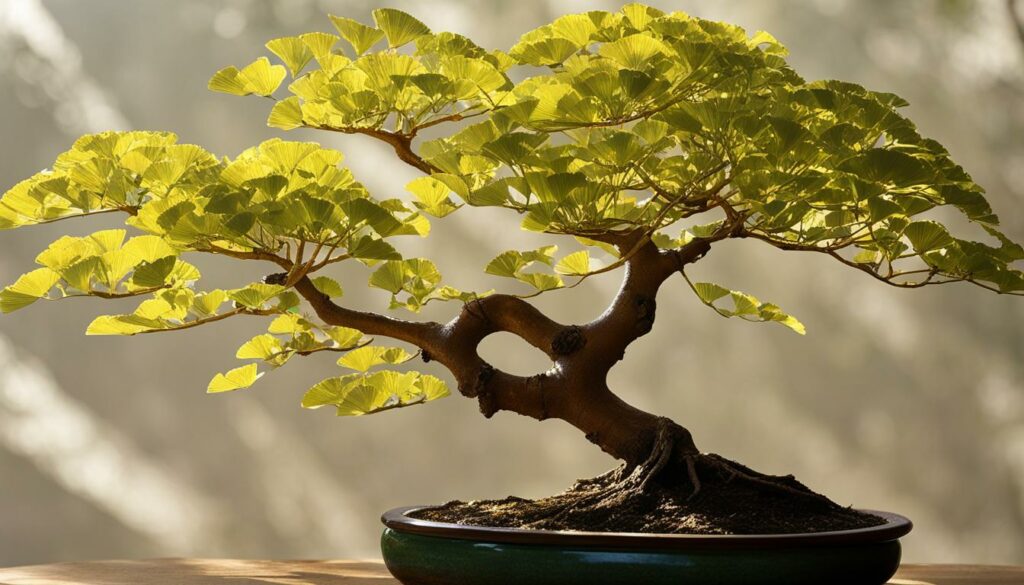
When you cultivate and care for a Ginkgo bonsai, you are connecting with an ancient species that has stood the test of time. With patience and dedication, you can witness the tree’s growth and evolution, creating a living masterpiece to be admired for generations to come.
Conclusion
In conclusion, the Ginkgo bonsai is a fascinating and beautiful species to cultivate. By choosing Ginkgo as your bonsai tree species, you can connect with the ancient wisdom and cultural significance of this unique tree. With proper knowledge and care, your Ginkgo bonsai can thrive and evolve over time, becoming a living masterpiece and symbol of longevity, endurance, and resilience.
Remember to provide your Ginkgo bonsai with the ideal growing conditions and specific care requirements, including pruning, wiring, and pest control. Adapt your care routine to the seasonal changes and adjust the styling and design of your bonsai to suit your preferences. By dedicating yourself to your Ginkgo bonsai, you can experience the joy and pride of nurturing a piece of ancient artistry.
Thank you for reading this comprehensive bonsai tree species guide, and we hope that your bonsai journey with Ginkgo will be a fulfilling and enriching experience. Remember to share your success and passion with other bonsai enthusiasts, and continue to explore the vast world of bonsai tree cultivation.
FAQ
What is Ginkgo bonsai?
Ginkgo bonsai refers to the art of cultivating and shaping the Ginkgo tree, scientifically known as Ginkgo biloba, into a miniature form. It involves meticulous care and training techniques to create a living masterpiece of ancient artistry.
What makes the Ginkgo tree unique?
The Ginkgo tree, also known as a “living fossil,” is a distinct and remarkable species that has remained virtually unchanged for millions of years. It has distinctive fan-shaped leaves, extraordinary resilience, and rich symbolic meaning, making it a popular choice for bonsai enthusiasts.
How do I cultivate Ginkgo bonsai?
To cultivate Ginkgo bonsai, you need to provide the tree with the ideal growing conditions. It thrives in well-draining soil and prefers a sunny location. Regular watering, proper fertilization, and suitable temperature regulation are essential for its health and vitality.
How do I care for Ginkgo bonsai?
Caring for Ginkgo bonsai involves regular pruning to maintain its shape and promote new growth. Wiring techniques may also be used to guide the branches. Keeping a watchful eye for pests and diseases is crucial, and proper pest control measures should be taken if necessary.
What should I consider during different seasons for Ginkgo bonsai care?
Each season requires specific considerations for Ginkgo bonsai care. During winter dormancy, the tree should be protected from extreme cold. In spring, it undergoes rejuvenation and requires increased watering and fertilization. Summer maintenance involves monitoring water needs and protecting the tree from excessive heat. In autumn, the Ginkgo bonsai exhibits stunning coloration, and leaf raking may be necessary.
How can I style and design my Ginkgo bonsai?
Styling and designing Ginkgo bonsai offer endless possibilities for creativity. Traditional styles such as formal upright, cascade, or windswept can be explored. Choosing the right pot or container is important for enhancing the overall aesthetic appeal of your Ginkgo bonsai.
What is the cultural significance of Ginkgo bonsai?
Ginkgo bonsai holds cultural significance and historical associations. In many cultures, the Ginkgo tree symbolizes longevity, endurance, and resilience. Growing and appreciating Ginkgo bonsai allows you to connect with the ancient wisdom and beauty of this remarkable species.
